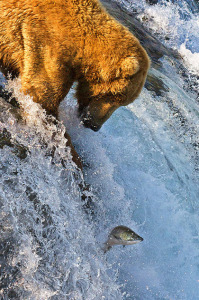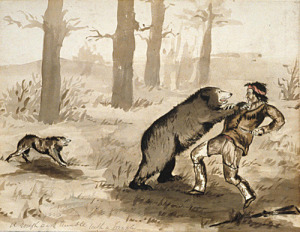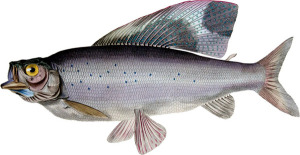Campfire tales
by John McPheeMy bandanna is rolled on the diagonal and retains water fairly well. I keep it knotted around my head, and now and again dip it into the river. The water is forty-six degrees. Against the temples, it is refrigerant and relieving. This has done away with the headaches that the sun caused in days before. The Arctic sun – penetrating, intense – seems not so much to shine as to strike. Even the trickles of water that run down my T-shirt feel good. Meanwhile, the river – the clearest, purest water I have ever seen flowing over rocks – breaks the light into flashes and sends them upward into the eyes. The headaches have reminded me of the kind that are sometimes caused by altitude, but, for all the fact that we have come down through mountains, we have not been higher than a few hundred feet above the level of the sea. Drifting now – a canoe, two kayaks – and thanking God it is not my turn in either of the kayaks, I lift my fish rod from the tines of a caribou rack (lashed there in mid-canoe to the duffel) and send a line flying toward a wall of bedrock by the edge of the stream. A grayling comes up and, after some hesitation, takes the lure and runs with it for a time. I disengage the lure and let the grayling go, being mindful not to wipe my hands on my shirt. Several days in use, the shirt is approaching filthy, but here among grizzly bears I would prefer to stink of humanity than of fish.
Paddling again, we move down long pools separated by short white pitches, looking to see whatever might appear in the low hills, in the cottonwood, in the white and black spruce – and in the river, too. Its bed is as distinct as if the water were not there. Everywhere, in fleets, are the oval shapes of salmon. They have moved the gravel and made redds, spawning craters, feet in diameter. They ignore the boats, but at times, and without apparent reason, they turn and shoot downriver, as if they have felt panic and have lost their resolve to get on with their loving and their dying. Some, already dead, lie whitening, grotesque, on the bottom, their bodies disassembling in the current. In a short time, not much will be left but the hooking jaws. Through the surface, meanwhile, the living salmon broach, freshen – make long, dolphinesque flights through the air – then fall to slap the water, to resume formation in the river, noses north, into the current. Looking over the side of the canoe is like staring down into a sky full of zeppelins.
Tracks are numerous, coming, going, multidirectional… Some of the moose tracks are punctuated with dewclaws. The grizzlies’ big toes are on the outside.”
A cloud, all black and silver, crosses the sun. I put on a wool shirt. In Alaska, where waters flow in many places without the questionable benefit of names, there are nineteen streams called Salmon – thirteen Salmon Creeks, six Salmon Rivers – of which this one, the Salmon River of the Brooks Range, is the most northern, its watershed wholly above the Arctic Circle. Rising in treeless alpine tundra, it falls south into the fringes of the boreal forest, the taiga, the upper limit of the Great North Woods. Tree lines tend to be digital here, fingering into protected valleys. Plants and animals are living on margin, in cycles that are always vulnerable to change. It is five o’clock in the afternoon. The cloud, moving on, reveals the sun again, and I take off the wool shirt. The sun has been up fourteen hours, and has hours to go before it sets. It seems to be rolling slowly down a slightly inclined plane. A tributary, the Kitlik, comes in from the north-west. It has formed with the Salmon River a raised, flat sand-and-gravel Mesopotamia – a good enough campsite, and, as a glance can tell, a fishing site to exaggerate the requirements of dinner.
There are five of us, four of whom are a state-federal study team. The subject of the study is the river. We pitch the tents side by side, two Alpine Draw-Tite tents, and gather and saw firewood: balsam poplar (more often called cottonwood); sticks of willow and alder; a whole young spruce, tip to root, dry now, torn free upriver by the ice of the breakup in spring. Tracks are numerous, coming, going, multidirectional, tracks wherever there is sand, and in gravel if it is fine enough to have taken an impression. Wolf tracks. The pointed pods of moose tracks. Tracks of the barren-ground grizzly. Some of the moose tracks are punctuated with dewclaws. The grizzlies’ big toes are on the outside.
The Kitlik, narrow, and clear as the Salmon, rushes in white to the larger river, and at the confluence is a pool that could be measured in fathoms. Two, anyway. With that depth, the water is apple green, and no less transparent. Salmon and grayling, distinct and dark, move into, out of, around the pool. Many grayling rest at the bottom. There is a pair of intimate salmon, the male circling her, circling, an endless attention of rings. Leaning over, watching, we nearly fall in. The gravel is loose at the river’s edge. In it is a large and recently gouged excavation, a fresh pit, close by the water. It was apparently made in a thrashing hurry. I imagine that a bear was watching the fish and got stirred up by the thought of grabbing one, but the water was too deep. Excited, lunging, the bear fell into the pool, and it flailed back at the soft gravel, gouging the pit while trying to get enough of a purchase to haul itself out. Who can say? Whatever the story may be, the pit is the sign that is trying to tell it.
It is our turn now to fish in the deep pool. We are having grayling for dinner – Arctic grayling of firm delicious flesh. On their skins are black flecks against a field of silvery iridescence. Their dorsal fins fan up to such height that grayling are scale-model sailfish. In the cycles of the years, and the millennia, not many people have fished this river. Forest Eskimos have long seined at its mouth, but only to the third bend upstream. Eskimo hunters and woodcutters, traversing the Salmon valley, feed themselves, in part, with grayling. In all, perhaps a dozen outsiders, so far as is known, have travelled, as we have, in boats down the length of the river. Hence the grayling here have hardly been, in the vernacular of angling, fished out. Over the centuries, they have scarcely been fished. The fire is high now and is rapidly making coals. Nineteen inches is about as long as a grayling will grow in north Alaska, so we agree to return to the river anything much smaller than that. As we do routinely, we take a count of the number needed – see who will share and who can manage on his own the two or three pounds of an entire fish. Dinner from our supplies will come in hot plastic water bags and be some form of desiccated mail-order stew – Mountain House Freeze Dried Caribou Cud – followed by Mountain House Freeze Dried fruit. Everyone wants a whole fish.
 Ursus arctos horribilis) catching salmon at Brooks Falls in Katmai National Park, Alaska. Dmitry Azovtsev/Wikimedia Commons” width=”199″ height=”300″>Five, then. Three of us pick up rods and address the river – Bob Fedeler, Stell Newman, and I. Pat Pourchot, of the federal Bureau of Outdoor Recreation, has not yet cast a line during the trip. As he puts it, he is phasing himself out of fishing. In his work, he makes many river trips. There will always be people along who want to fish, he reasons, and by removing himself he reduces the number. He has wearied of take-and-put fishing, of molesting the fish, of shocking the ones that, for one reason or another, go back. He says he wonders what kind of day a fish will have after spending some time on a hook. John Kauffmann has largely ignored the fishing, too. A National Park Service planner who has been working for five years in Arctic Alaska, he is a New England mastertouch dry-fly fisherman, and up here his bamboo ballet is regarded as effete. Others taunt him. He will not rise. But neither will the grayling to his Black Gnats, his Dark Cahills, his Quill Gordons. So – tall, angular – he sits and observes, and his short grey beard conceals his disgust. He does agree to time the event. He looks at his watch. Invisible lines, glittering lures go spinning to the river, sink in the pool. The rods bend. Grayling do not sulk, like the salmon. They hit and go. In nine minutes, we have our five. They are seventeen, eighteen inches long. We clean them in the Kitlik, with care that all the waste is taken by the stream. We have a grill with us, and our method with grayling is simply to set them, unscaled, fins intact, over the fire and broil them like steaks. In minutes, they are ready, and beneath their skins is a brown-streaked white flesh that is in no way inferior to the meat of trout. The sail, the dorsal fin, is an age-old remedy for toothache. Chew the fin and the pain subsides. No one has a toothache. The fins go into the fire.
Ursus arctos horribilis) catching salmon at Brooks Falls in Katmai National Park, Alaska. Dmitry Azovtsev/Wikimedia Commons” width=”199″ height=”300″>Five, then. Three of us pick up rods and address the river – Bob Fedeler, Stell Newman, and I. Pat Pourchot, of the federal Bureau of Outdoor Recreation, has not yet cast a line during the trip. As he puts it, he is phasing himself out of fishing. In his work, he makes many river trips. There will always be people along who want to fish, he reasons, and by removing himself he reduces the number. He has wearied of take-and-put fishing, of molesting the fish, of shocking the ones that, for one reason or another, go back. He says he wonders what kind of day a fish will have after spending some time on a hook. John Kauffmann has largely ignored the fishing, too. A National Park Service planner who has been working for five years in Arctic Alaska, he is a New England mastertouch dry-fly fisherman, and up here his bamboo ballet is regarded as effete. Others taunt him. He will not rise. But neither will the grayling to his Black Gnats, his Dark Cahills, his Quill Gordons. So – tall, angular – he sits and observes, and his short grey beard conceals his disgust. He does agree to time the event. He looks at his watch. Invisible lines, glittering lures go spinning to the river, sink in the pool. The rods bend. Grayling do not sulk, like the salmon. They hit and go. In nine minutes, we have our five. They are seventeen, eighteen inches long. We clean them in the Kitlik, with care that all the waste is taken by the stream. We have a grill with us, and our method with grayling is simply to set them, unscaled, fins intact, over the fire and broil them like steaks. In minutes, they are ready, and beneath their skins is a brown-streaked white flesh that is in no way inferior to the meat of trout. The sail, the dorsal fin, is an age-old remedy for toothache. Chew the fin and the pain subsides. No one has a toothache. The fins go into the fire.
When I tugged, there was a slight movement at the other end… A couple of minutes later, I landed a Safeway Stores Cragmont orange-soda can, full of silt and sand.”
When a lure falls into the water, it can become arrested at the bottom, and you tug and haul at the line and walk in an arc, whipping the rod, four-lettering the apparent snag that has spoiled the cast and is stealing your equipment. Tug some more. Possibly a small boulder or a sunken log has stopped the lure. Possibly not, too. You may have a pensive salmon. He contemplates. He is not yet ready to present his response. Not long before this river trip, I was fishing in lake-and-stream country north-west of Anchorage and the line became snagged in a way that to me suggested big things below. When I tugged, there was a slight movement at the other end, a gesture in my direction, the signal – obviously – of an irritated salmon getting ready to explode. I strained the line. It moved a bit more in my direction. A couple of minutes later, I landed a Safeway Stores Cragmont orange-soda can, full of silt and sand.
Over the fire now, I tell that story, and Bob Fedeler responds that that country near Anchorage, where many people have summer cottages, has long since been virtually fished out and is now supplied with stocked rainbows from a state hatchery. “That is the myth of Alaska,” he says. “The myth is that in Alaska there’s a fish on every cast, a moose behind every tree. But the fish and the moose aren’t there. People go out with high expectations, and they’re disappointed. To get to the headwaters of a river like this one takes a lot of money. The state needs to look to the budgets and desires of people who cannot afford to come to a place like this.”
…
Grayling are particularly fast swimmers. In Arctic Alaska, where small rivers like this one for the most part freeze solid, grayling can move big distances rapidly to seek out safe deep holes for winter. They are veterans of runs for life. They are indices, too, of the qualities of a stream. They seek out fast, cold, clear water. So do trout, of course, but grayling have higher standards. Trout will settle for sub-perfect waters in which grayling will refuse to live.
 A rough and tumble with a grizzley by Harry Bullock Webster (watercolour), c. 1874–80. University of British Columbia Archives/Wikimedia Commons” width=”300″ height=”232″>The sun, which two hours ago was behind the apex of a spruce across the Kitlik, is now far to the right of that and somewhat closer to the ground. All day, while the sun describes a horseshoe around the margins of the sky, the light is of the rich kind that in more southern places comes at evening, heightening walls and shadowing eaves, bringing out of things the beauty of relief. It is ten-thirty, and about time for bed. Everything burnable – and more, too – has long since gone into the fire. We burn our plastic freeze-dry bags and we burn our Swiss Miss cocoa packets. If we have cans – devilled ham, Spam – we burn them, until all hint of their contents is gone. This is in part tidiness. Everything the fire does not consume is later put into bags that will go with us all the way through and out of these tens of thousands of square miles of wilderness. Nothing is buried. Also, the burning of the cans is an expression of regard for bears. The scent of the food is scorched away. It is not necessary for us to string up our meat high in the air. What meat we have is either dried or canned, and is presumably without odour. I can think of places where all these foil-lined packets and plastic containers might be an affront to the woods, but in Alaska their advantage is great. They are a way to move through bear country without drawing bears. More accurately, I should say “without in all likelihood drawing bears”’. Unopened cans of sardines have been found in the scat of grizzlies.
A rough and tumble with a grizzley by Harry Bullock Webster (watercolour), c. 1874–80. University of British Columbia Archives/Wikimedia Commons” width=”300″ height=”232″>The sun, which two hours ago was behind the apex of a spruce across the Kitlik, is now far to the right of that and somewhat closer to the ground. All day, while the sun describes a horseshoe around the margins of the sky, the light is of the rich kind that in more southern places comes at evening, heightening walls and shadowing eaves, bringing out of things the beauty of relief. It is ten-thirty, and about time for bed. Everything burnable – and more, too – has long since gone into the fire. We burn our plastic freeze-dry bags and we burn our Swiss Miss cocoa packets. If we have cans – devilled ham, Spam – we burn them, until all hint of their contents is gone. This is in part tidiness. Everything the fire does not consume is later put into bags that will go with us all the way through and out of these tens of thousands of square miles of wilderness. Nothing is buried. Also, the burning of the cans is an expression of regard for bears. The scent of the food is scorched away. It is not necessary for us to string up our meat high in the air. What meat we have is either dried or canned, and is presumably without odour. I can think of places where all these foil-lined packets and plastic containers might be an affront to the woods, but in Alaska their advantage is great. They are a way to move through bear country without drawing bears. More accurately, I should say “without in all likelihood drawing bears”’. Unopened cans of sardines have been found in the scat of grizzlies.
Bear stories, for a time, traverse the campfire. John Kauffmann remembers when Ave Thayer, the refuge manager of the Arctic National Wildlife Range, surprised a grizzly one day and when the bear charged stood his ground. In a low voice, Thayer said, “Shoo!” The grizzly stopped short. The two faced each other ten feet apart, neither making a move. Thayer cautiously stepped backward. The grizzly slowly advanced. Thayer said, “Shoo!” The grizzly stopped. Thayer walked backward, with no sudden starts. The grizzly followed. In such manner, Thayer walked backward about two hundred yards. Then the grizzly moved off a distance and walked parallel to him all the way – a mile or so – to his camp, where it lost interest and turned away.
Fedeler makes the point that grizzlies in general will avoid people and people should avoid them, by not foolishly getting in their way – by not, for example, pitching a tent on a bear trail. Once, not long ago, a writer visiting Alaska pitched his tent on a bear trail. A bear removed the writer from the tent, ate him, and left nothing much but the pencil.
“All right, that’s enough!” decrees Pat Pourchot, official leader of the trip. “No more bear stories. It is never a good idea to tell bear stories at night. I’ve known people to wake up screaming in their sleeping bags.”
Extracted from Coming into the Country, published in a new edition by Daunt Books.
 John McPhee was born in Princeton, New Jersey, and educated at Princeton and Cambridge. He has been a staff writer on The New Yorker since 1965. Acknowledged as a pioneer in creative non-fiction, he has written nearly 30 books including Oranges (1967), Coming into the Country (1977), The Control of Nature (1989), The Founding Fish (2002), Uncommon Carriers (2007) and Silk Parachute (2011). He received the Award in Literature from the Academy of Arts and Letters in 1977, and in 1999 was awarded the Pulitzer Prize for Annals of the Former World. He has taught non-fiction writing at Princeton since 1974. Coming into the Country, with a new introduction by Robert Macfarlane, is published by Daunt Books. Read more.
John McPhee was born in Princeton, New Jersey, and educated at Princeton and Cambridge. He has been a staff writer on The New Yorker since 1965. Acknowledged as a pioneer in creative non-fiction, he has written nearly 30 books including Oranges (1967), Coming into the Country (1977), The Control of Nature (1989), The Founding Fish (2002), Uncommon Carriers (2007) and Silk Parachute (2011). He received the Award in Literature from the Academy of Arts and Letters in 1977, and in 1999 was awarded the Pulitzer Prize for Annals of the Former World. He has taught non-fiction writing at Princeton since 1974. Coming into the Country, with a new introduction by Robert Macfarlane, is published by Daunt Books. Read more.
newyorker.com/contributors/john-mcphee
Author portrait © Peter Cook


 Thymallus arctics arctics). Illustration by John Curtis for Sir John Franklin’s Narrative of a Journey to the Shores of the Polar Sea in the Years 1819–22 (London: John Murray, 1823). Wikimedia Commons” width=”300″ height=”155″>
Thymallus arctics arctics). Illustration by John Curtis for Sir John Franklin’s Narrative of a Journey to the Shores of the Polar Sea in the Years 1819–22 (London: John Murray, 1823). Wikimedia Commons” width=”300″ height=”155″>